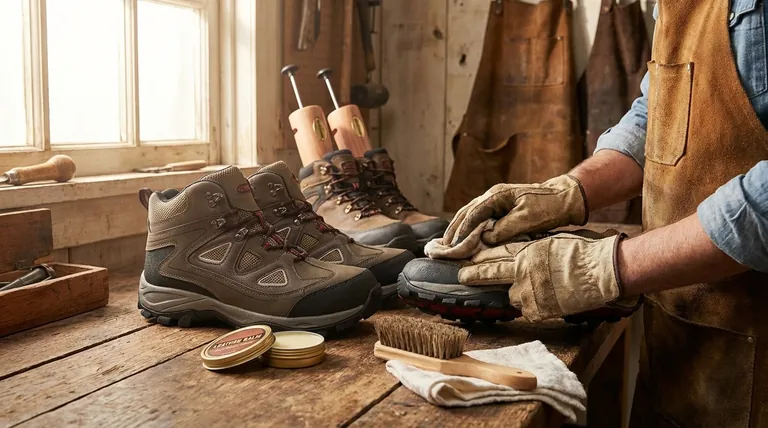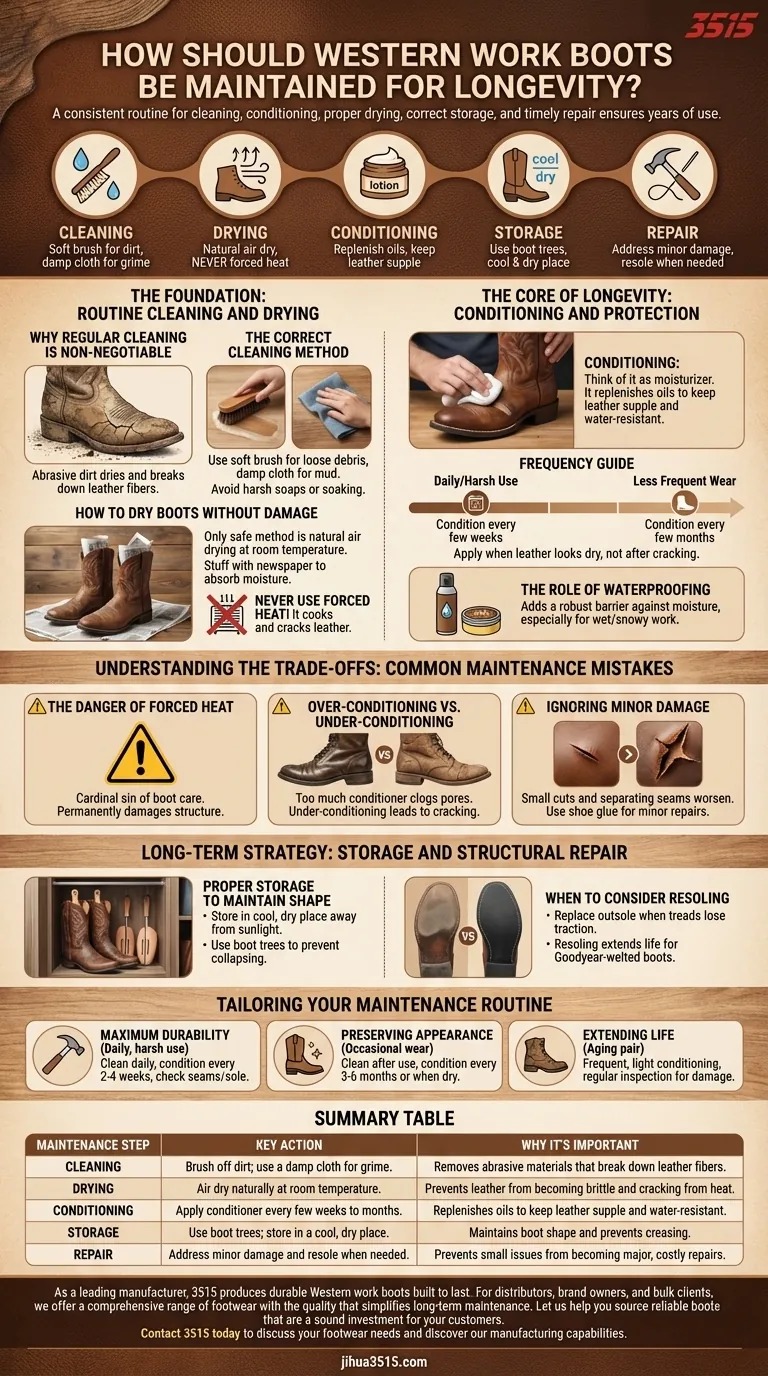To ensure your Western work boots last for years, you must adopt a consistent maintenance routine focused on five key areas: cleaning, conditioning, proper drying, correct storage, and timely repair. This proactive care prevents the leather from drying out, cracking, and losing its structural integrity, preserving both its function and appearance.
The core principle is simple: leather is a skin that requires care to survive. Ignoring your boots guarantees they will fail prematurely, while a consistent, simple routine of cleaning and conditioning is the single most effective way to protect your investment and ensure they remain comfortable and durable.

The Foundation: Routine Cleaning and Drying
The most frequent and critical maintenance happens right after you take your boots off. Dirt, mud, and chemicals are the primary enemies of healthy leather.
Why Regular Cleaning is Non-Negotiable
Abrasive materials like dirt, gravel, and chemicals actively break down leather fibers when left on the boot's surface. This process slowly dries the leather, leading to stiffness and eventually cracking, especially at flex points.
The Correct Cleaning Method
Use a soft brush to remove loose, dry dirt and debris. For caked-on mud or grime, a damp cloth is sufficient. Avoid soaking the boots or using harsh soaps, which can strip the leather of its essential natural oils.
How to Dry Boots Without Causing Damage
Never use direct, forced heat to dry your boots. Placing them near a heater, vent, or in direct sunlight will cook the leather, causing it to become brittle and crack.
The only safe method is to let them air dry naturally at room temperature in a well-ventilated area. If they are particularly wet, stuffing them with newspaper can help absorb excess moisture from the inside.
The Core of Longevity: Conditioning and Protection
Cleaning removes harmful contaminants; conditioning restores the moisture that keeps leather strong and flexible.
Understanding Leather Conditioning
Think of a leather conditioner as a moisturizer for your boots. It replenishes the oils within the leather's pores, keeping the material supple, preventing cracks, and maintaining its natural water resistance.
How Often to Condition
The frequency depends entirely on your usage and environment. For boots worn daily in harsh conditions, conditioning every few weeks may be necessary. For less frequent wear, conditioning every few months is a good rule of thumb. The key is to apply it when the leather starts to look dry, not after it has already started to crack.
The Role of Waterproofing
While conditioning adds some water resistance, a dedicated waterproofing treatment provides a more robust barrier against moisture. Applying a spray or wax, especially to the seams, is highly recommended for work in wet or snowy environments.
Understanding the Trade-offs: Common Maintenance Mistakes
Knowing what not to do is as important as knowing what to do. These common mistakes can ruin a quality pair of boots faster than simple neglect.
The Danger of Forced Heat
As mentioned, this is the cardinal sin of boot care. The intense, dry heat rapidly pulls all moisture and oils from the leather, permanently damaging its structure. Always choose slow, natural drying over speed.
Over-Conditioning vs. Under-Conditioning
While essential, over-conditioning can also be a problem. Applying too much conditioner can clog the leather's pores, making it feel greasy and preventing it from breathing. Under-conditioning is more common and leads to cracking, so it's better to apply thin, even coats as needed rather than a single thick, heavy one.
Ignoring Minor Damage
Small cuts in the leather or separating seams will only get worse. Addressing minor issues with a product like shoe glue can prevent a small problem from turning into a major, costly repair.
Long-Term Strategy: Storage and Structural Repair
How you treat your boots when they're off your feet has a significant impact on their lifespan.
Proper Storage to Maintain Shape
When not in use, store your boots in a cool, dry place away from sunlight. Using boot trees or stuffing the shafts with newspaper is critical for helping them maintain their shape and preventing the ankles from collapsing and creasing.
When to Consider Resoling
The outsole is a wear item. Once the treads become smooth and lose their traction, the boot's utility is compromised. For high-quality, Goodyear-welted boots, a professional cobbler can replace the entire sole. This resoling process can dramatically extend the life of the boot, often allowing a single pair to last for many years.
Tailoring Your Maintenance Routine
Your specific needs dictate your maintenance schedule. Use these guidelines to create a routine that fits your use case.
- If your primary focus is maximum durability for daily, harsh use: Clean your boots daily and condition them every 2-4 weeks, paying close attention to wear and tear on the seams and sole.
- If your primary focus is preserving the appearance for occasional wear: Clean boots after each use and condition them every 3-6 months or whenever the leather appears dry.
- If your primary focus is extending the life of an aging pair: Focus on frequent, light conditioning to restore suppleness, and inspect the soles and seams regularly for any damage that needs immediate repair.
Ultimately, consistent care is the key to getting the most out of your Western work boots.
Summary Table:
| Maintenance Step | Key Action | Why It's Important |
|---|---|---|
| Cleaning | Brush off dirt; use a damp cloth for grime. | Removes abrasive materials that break down leather fibers. |
| Drying | Air dry naturally at room temperature. | Prevents leather from becoming brittle and cracking from heat. |
| Conditioning | Apply conditioner every few weeks to months. | Replenishes oils to keep leather supple and water-resistant. |
| Storage | Use boot trees; store in a cool, dry place. | Maintains boot shape and prevents creasing. |
| Repair | Address minor damage and resole when needed. | Prevents small issues from becoming major, costly repairs. |
As a leading manufacturer, 3515 produces durable Western work boots built to last. For distributors, brand owners, and bulk clients, we offer a comprehensive range of footwear with the quality that simplifies long-term maintenance. Let us help you source reliable boots that are a sound investment for your customers.
Contact 3515 today to discuss your footwear needs and discover our manufacturing capabilities.
Visual Guide

Related Products
- Safety Footwear Wholesale Manufacturer for Custom OEM/ODM Production
- Premium KPU Injection Athletic Style Safety Shoes
- Premium Flame-Retardant Waterproof Safety Boots and Shoes
- Wholesale Safety Footwear Manufacturer for Bulk & Custom OEM Orders
- High Performance Fire-Retardant Waterproof Safety Boots
People Also Ask
- What do heavy duty boots do? Protect Your Feet in Demanding Work Environments
- Is it normal to wear shoes in the house? A Guide to Hygiene, Comfort & Culture
- What are the cultural perspectives on wearing shoes in the house? A Guide to Home Etiquette & Hygiene
- Is safety-toe as good as steel toe? Choose the Right Protection for Your Job
- What cultural and environmental considerations are tied to wearing shoes indoors? Balance Hygiene, Tradition, and Foot Health



















